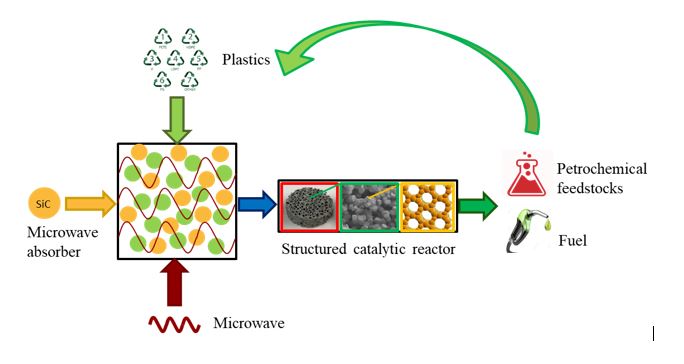Video Article Open Access
Catalytic microwave-assisted pyrolysis for chemical recycling of plastic waste
Roger Ruan1*, Nan Zhou1, Leilei Dai1, Yanling Cheng1, 2, Yunpu Wang1,3, Yuhuan Liu3, Paul Chen1
1Center for Biorefining and Department of Bioproducts and Biosystems Engineering, University of Minnesota, St. Paul, MN 55108, USA
2Biochemical Engineering College, Beijing Union University, Beijing 100023, China
3Engineering Research Center for Biomass Conversion, Ministry of Education, Nanchang University, Nanchang, Jiangxi, 330047, China
Vid. Proc. Adv. Mater., Volume 1, Article ID 2020-0816 (2020)
DOI: 10.5185/vpoam.2020.0816
Publication Date (Web): 02 Nov 2020
Copyright © IAAM
Graphical Abstract

Abstract
The increasing rates of plastic production and waste plastic accumulation pose a serious challenge to the society, environment, and economy. Current mechanical recycling process is limited by the sorting/pretreatment of plastic waste and degradation of plastics during the process, which calls for more efficient recycling strategies. Catalytic microwave-assisted pyrolysis could serve as a feasible approach to chemical recycling of waste plastics and producing fuel and petrochemical feedstocks such as naphtha. This lecture presents a series of our recent work on the aspects of pyrolysis reactor design and catalyst development with the goal of advancing this technology towards industrial applications. A lab-scale continuous microwave-assisted pyrolysis system with a processing capacity of 200 kg plastics per day was developed, which features continuous downdraft operation and a mixing ball bed reactor. The incorporation of silicon carbide as microwave absorbents into the microwave heating process enabled fast, uniform and energy-efficient heating for the process. A baseline test of the system using conventional ZSM-5 catalyst obtained a 57 wt.% yield for C5-C22 liquid hydrocarbons from polyolefin-based plastics. Energy saving of the process compared to production of similar products from virgin materials was estimated to be 32% by using the Materials Flows through Industry supply chain analysis tool. In order the improve the yield and quality of the liquid hydrocarbon products, a series of catalysts were tested and compared on a lab-scale setting. Notably, relay catalysis of Al2O3 followed by ZSM-5 achieved up to 100% conversion into monoaromatics and C5-C12 alkanes/olefins at a catalyst to plastic ratio of 4:1; Y5.1, F20 zeolites and Al2O3 promoted the production of alkanes and alkenes mainly in the C5-C23 range; MCM-41 led to the formation of C13-C23 alkanes and alkenes with a selectivity of 86.6%; ZSM-5 favored the production of aromatics with a selectivity of 70%. In addition to developing and selecting the proper catalyst material, the catalytic reactor also needs to be carefully designed such that sufficient heat and mass transfer within the catalyst bed is ensured during operation and the catalyst regeneration procedure can be conveniently practiced. Conventional designs such as the randomly packed bed could be problematic in the process since catalyst deactivation and coke/wax build-up is very likely. A probable solution to this issue is a structured catalytic reactor consisting of a structured packing with coated catalysts, e.g. ZSM-5 coatings on a SiC foam support. This structured catalyst has been tested in a lab-scale setting for upgrading pyrolytic vapours and results showed that it outperformed many other catalytic reactor designs in terms of catalytic activity and stability. In addition, the composite catalysts could be regenerated and reused while well preserving its material properties and catalytic activity after multiple reaction-regeneration cycles.
Keywords
Catalyst, microwave-assisted pyrolysis, chemical recycling, plastic waste.
Acknowledgement
This research is supported in part by funding from Xcel Energy (RD4-1), and University of Minnesota Center for Biorefining.
Biography
Roger Ruan is a fellow of ASABE and a fellow of IFT, also a top cited author in the area of agricultural and biological sciences with an h-index of 65, i10-index of 271 and over 16,200 citations. His research focuses on various aspects of renewable energy, environment, sustainable development, and food engineering. His current interests include complete solid and liquid waste utilization, catalytic microwave assisted pyrolysis and gasification of solid wastes for chemicals, materials, and energy production, photocatalytic, nonthermal plasma, UV and intensive pulse light (IPL) synthesis of ammonia and nitrogen products, and inactivation of bacteria and virus. Professor Ruan has published over 500 papers in refereed journals, co-authored 2 books, 20 book chapters, and holds 18 US patents. He has supervised over 65 graduate students, 130 post-doctors, research fellows, and other engineers and scientists, and 13 of his Ph.D. students and 9 other post-doctors hold university faculty positions. He has received over 175 projects totaling over $45 million in various funding for research, including major funding from USDA, DOE, DOT, DOD, and industries. He has served as an editorial board member of Bioresource Technology, Engineering, The Open Plasma Physics Journal, and Associate Editor of Transactions of ASABE, Engineering Applications in Agriculture, and Transactions of CSAE, and Chairman of Editorial Board and Editor-in-Chief of International Journal of Agri. and Biol. Engineering. Professor Ruan has also given over 300 keynote lectures, invited symposium presentations, company seminars, and short courses. He has taught many undergraduate and graduate courses, including Renewable energy technologies, Biological process engineering, Managing water in food and biological systems, Instrumentation and control for biological systems, Food process engineering, and Engineering principles and applications, etc.
Video Proceedings of Advanced Materials

Upcoming Congress



